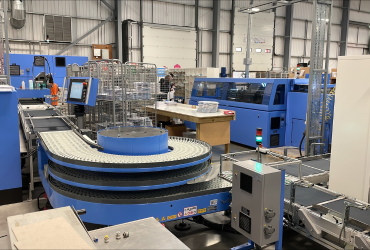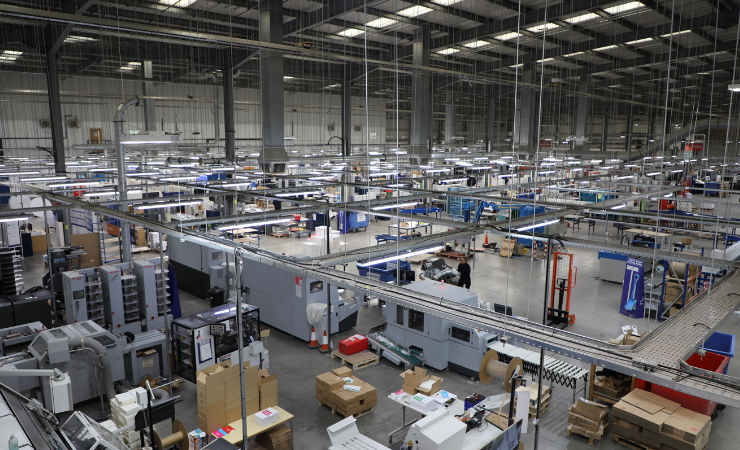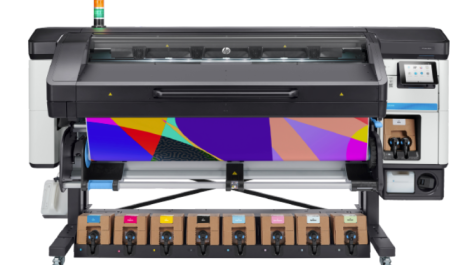With life not getting noticeably easier for printers so far in 2024, we look at how turning to trade support can help increase your product range and margins, allowing diversification or closer focus on high value work.
With the UK technically in recession after two successive quarters of falling GDP, including a worse-than expected fourth quarter of 2023 as household reined in Christmas expenditure in response to rising retail prices and borrowing costs, it doesn’t seem like the most optimistic time for commercial print, often seen as a bellwether of the economy.
But doom and gloom is very much not on the cards for the UK’s trade print sector, where investment continues and ambitious growth targets are still being set. The positive attitude is perhaps
best exemplified by Where The Trade Buys’ (WTTB) Gary Peeling, who says, ‘Fear can be paralysing for businesses and being afraid can have a knock-on effect on demand and growth.
‘Reacting less and acting more will be our watchwords, going forward; you can’t wait around for bad – or good – fortune, both come and go.’
Richard Campbell, the new MD at Northside Graphics, which runs the TradeDigitalPrint websites for UK and Ireland, sees it as more of the same. ‘The biggest challenge to our business is the same one as it’s always been, the macro environment, which is challenging in both of the markets in which we operate, UK and Ireland,’ he says.
‘Costs are going up and customer expectations also continue to grow. So we are doing what we have always done; keeping a keen eye on pricing to make sure our customers are getting really good value.’
A focus on value and competitive pricing is arguably business as usual for the competitive trade sector, but Tradeprint’s Anthony Rowell alludes to ‘pivotal issues’ affecting both printer and their customers:
‘The rapid development in both automation and digital printing methods demands that companies remain well-informed about technological progress to maintain their market edge. Additionally, ongoing disruptions in supply chains are impacting the availability and cost of essential materials.
‘This is further intensified by increasing environmental issues. The demand for sustainable and eco-credible printing solutions is escalating, driven by both regulatory bodies and consumer preferences. Moreover, there is a shift in customer expectations, with an emphasis on quicker delivery times, bespoke products, and superior quality at competitive rates.’
It’s also the case that the political maxim ‘never waste a good crisis’ applies here. Steve Wenlock at Flexpress notes that ‘every situation presents opportunities, as well as threats, so we just work harder to exploit whatever opportunities may be present’, while Mr Peeling agrees and summarises his call to action thus: ‘Don’t wait for the environment to be perfect, it never is’.
Why go trade?
That sounds like a pretty comprehensive description of the issues facing all printers, so what is the trade printers’ pitch? Do current circumstances merit altering the proposition, or merely strengthen existing reasons for looking outside your own factory to get things printed?
Mr Wenlock feels it bolsters the existing rationale, arguing, ‘Financial pressures and political uncertainty are making a lot of smaller printers ever more cautious about investing in expensive equipment to fulfil occasional orders. It makes far more sense, particularly now, to outsource to a capable and trustworthy trade printer that can produce what you need reliably and cost-effectively.’
Mr Campbell concurs, suggesting that this is already happening: ‘Our sales continue to grow on our trade sites, which indicates where the industry is going in terms of buying habits and the move to online. We see a growing number of printers choosing to use us rather than continue trying to produce the work themselves or get someone locally to produce it.’

An automated Müller Martini binding and trimming line supports book-of-one production at WTTB.
Macauley Hardeman of Route 1 adds, ‘We don’t believe these reasons for using a trade supplier will fundamentally change, although we are seeing an increasing number of partners focusing more on customer-facing aspects of their operations,’ suggesting that at least some printers are prioritising winning business over the act of producing it.
Mr Peeling backs that view too, saying, ‘Trade printers have always provided capabilities, solutions and expertise that would necessitate several years of internal development and significant capital investment for companies to establish [themselves].’ ‘The invaluable expertise we collectively bring to the table is pivotal. Through outsourcing, trade resellers can focus their time and effort on cultivating closer relationships with key customers and identifying project streams that yield optimal margins or demonstrate strong demand,’ he adds.
For Mr Rowell, it’s about understanding customers’ needs and motivations. ‘We recognise that print projects aren’t ‘widgets’– they have meaning and applications and are often an important driver to support our customers growth with a human touch,’ he says.
To back up their arguments and deliver what they promise, our trade printers are continuing to invest in a variety of directions. At Tradeprint this means technology – advanced printing techniques, automation and using AI to boost efficiency and quality – as well as expanding the range of services and product catalogue to include more customised products, self-serve design tools, an ‘amazing’ range of prepress and design options, plus a Resource Hub and sustainable solutions, according to Mr Rowell, who also points to the company’s buying strength as part of the Cimpress group. Direct connection with clients’ e-commerce via API is also offered, something that Solopress has also done, reducing transactional costs and admin overhead.
At WTTB, a 2024 goal is to overhaul the online pricing engine for ‘core’ categories, in order to enable customers to get an immediate price on most specifications of most key products. ‘First often secures the order, this new pricing engine will mean fewer delays waiting for a bespoke estimate,’ explains Mr Peeling.
Improving the user experience is also central to Northside’s plans, with both the UK and Ireland trade websites having recently been re-launched with a ‘completely different look and feel’, according to Mr Campbell. Further products recently added include labels on a roll, a bespoke products service and 13 same-day delivery products, with a ‘large pipeline’ of further new products to come in 2024.
The focus at Route 1 is very much on books, following the acquisition and integration of Kingsbury Press into the Wath-Upon-Dearne production site. ‘We’ve recently rolled out a significant expansion to our perfect bound book range, with new stock options and hardcover variants. Books will continue to be our main focus, so you can expect to see the introduction of additional binding types, innovative embellishment options, and much more throughout the year,’ confirms Mr Hardeman.
The South Yorkshire production capability will no doubt be bolstered by the addition of the company’s second Landa S10P B1 digital press, scheduled for the spring of 2024. Route 1 probably outscores just about everyone in terms of spend, too, with the Landa being part of a £5 million planned investment; further details of this are expected to be announced later in 2024.
Mr Wenlock says, ‘For us, it’s less about introducing new products and more about improving what we already do,’ but that still requires investment. He says £500,000 has already been spent this year, with a highlight being the purchase of a Duplo DuSense DDC8000 B2 digital embellishment press, which will enable ‘sensory spot UV and metallic foils to be applied to a greater range of products, ‘more cost-effectively and faster than ever’.
No drupa delay
It looks like the imminent drupa isn’t causing any delay to investment plans, though its influence on the market is undeniable. ‘We are always looking three to four years down the line, so drupa 2024 will probably not change our plans but may help to inform us better,’ opines Mr Campbell. Mr Rowell is enthusiastic about the return of the event, noting, ‘I think the anticipation of new technology announcements presented at the event will significantly shape future investment strategies in our amazing sector’.
At WTTB there’s no hanging around for possible announcements, it’s a case of buying available kit as and when it’s justified. Mr Peeling gives the example of Müller Martini PUR and case-binding equipment installed in September 2023, which he says supports one-book publication through to offset runs and operates with zero makeready thanks to the use of job barcodes in the trim area of the books.
Summarising the outlook, Route 1’s Mr Hardeman says, ‘We have entered 2024 with cautious optimism. No doubt there will be some big challenge that hits us all this year but the one thing we’re confident in is the amazing ability of UK businesses to adapt and make it work!’.
Tradeprint sees opportunities across the board, from direct mail to promotional and gift offerings to exhibition graphics, plus work that should arise from the expected general election, whenever it comes. ‘We think there’s some great opportunities for growth out there and we are super-determined to grow in a sustainable, profitable way,’ enthuses Mr Rowell.
Mr Campbell at Northside perhaps puts it most succinctly for everyone: ‘2024 is about continuing to do what we have always done while offering an even bigger range of products and services to our customers.’
If you’re not already using trade services to benefit from their equipment and expertise, it’s surely worth taking a look – there’s nothing to lose and potentially a lot to gain.
This article was first published in the February/March 2024 issue of Digital Printer, which you can read online here.





